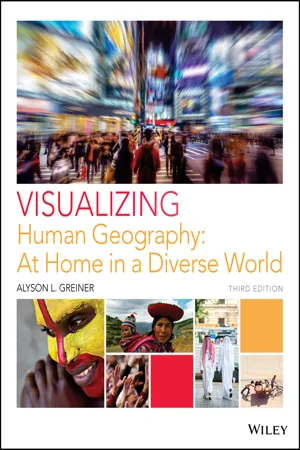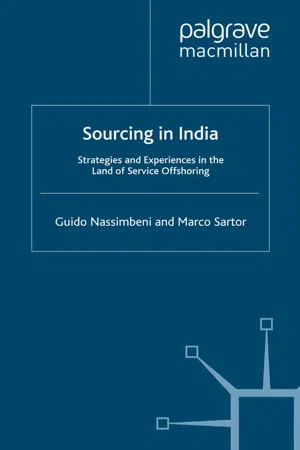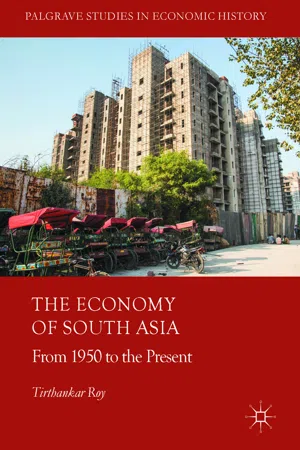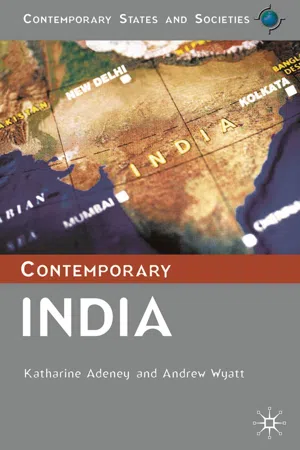Geography
Development of India
India's development has been shaped by its diverse geography, including the Himalayas, fertile plains, and coastal regions. The country's economic growth has been influenced by its agricultural, industrial, and service sectors, with rapid urbanization and infrastructure development playing key roles. India's development is also impacted by environmental challenges such as water scarcity and pollution.
Written by Perlego with AI-assistance
Related key terms
1 of 5
7 Key excerpts on "Development of India"
- eBook - PDF
- Erin H. Fouberg, William G. Moseley(Authors)
- 2017(Publication Date)
- Wiley(Publisher)
Geographers who study development generally avoid narrowly defining development as economic growth. Instead, they focus on how economies change over time, the implications of these changes for human well-being, and the connections between development in one place and another. This broad conception of development in geography encompasses a lot of different perspectives within the discipline. This section of the chapter examines ideas about development within geography and how ideas have changed over time. Development as Modernization After World War II, colonies in Asia and Africa gained indepen- dence, and the number of states in the world quickly grew. Scholars in geography and other disciplines, in an attempt to advise newly independent countries about how to develop, sought to explain why some countries developed economically while others did not. Scholars looked for steps or stages that the newly independent countries could follow. This group of theories, often collectively referred to under the umbrella term modernization, suggested that the European industrial econ- omy was the ideal or pinnacle stage of development. These theorists argued that with the right combination of capital, know-how, and attitude, economic growth would pro- ceed down a certain path already forged by the wealthy coun- tries of the world. They posited that countries would make a transition from traditional to modern states. While these theories were most popular in economics, they influenced thinking in geography and other disciplines as well. FIGURE 3.6 Rostow’s ladder of development. One way to represent Rostow’s modernization theory is as a ladder of development, with each rung representing one of his five stages: (1) Traditional or preindustrial, (2) preconditions for take-off, (3) take-off into self-sustaining growth, (4) drive to maturity, and (5) the age of mass consumption. - eBook - PDF
Visualizing Human Geography
At Home in a Diverse World
- Alyson L. Greiner(Author)
- 2017(Publication Date)
- Wiley(Publisher)
4. Identify geographic and institutional factors that can affect development. O ne of the axioms of development is that, no matter how it is mea- sured, it is geographically uneven. Human geographers study the differences in development from one place or region to another as well as the social and environmental consequences of development. When comparing countries or regions on the basis of their levels of development, different terms and classifica- tions are used such as high-, middle-, and low-income coun- tries, or more developed and less developed countries. The terms First World and Third World are problematic because they reinforce a view that less developed countries are in- trinsically inferior. Alternatively, Global North and Global South refer to richer and poorer regions in the world, but the terms are not strictly geographically accurate. India, for example, is usually classified as a country in the Global South even though it is in the northern hemisphere. For a long time, the terms developed and developing have been used to categorize countries. These terms are not strictly defined, but general usage recognizes Austra- lia, New Zealand, Japan, Europe, Canada, and the United States as developed. Recently, however, the usefulness of these terms has also been questioned. Part of the concern is that these terms mask a great deal of variation within both categories. Even within so-called “developed” coun- tries, much work remains to be done to ensure a better quality of life for people. The most important point here is that we recognize the limitations of such categories. The study of development is always a normative project. The term normative refers to the establishment of standards, or norms, to help measure the quality of life and economic prosperity of groups of people. Conven- tional views of development are strongly associated with normative ideas of progress, advancement, and social betterment. - eBook - PDF
Sourcing in India
Strategies and Experiences in the Land of Service Offshoring
- Guido Nassimbeni, Marco Sartor(Authors)
- 2008(Publication Date)
- Palgrave Macmillan(Publisher)
2 India: a Geo-economic Overview 2.1. Introduction During its history India rarely was a unified entity: local dynasties, for- eign invasions, colonial possession have followed one another, creating cultural, linguistic and religious specificities. However, in the past some unifying elements developed, which have helped to form Indian society since the Medieval Ages. Gathering these elements is important not only for the researcher who intends to analyse the sourcing phenomenon, but also for western companies that intend to establish production and sourcing activities in this market and who are confronted with a social and institutional context quite different from the domestic one. In the next sections a short presentation of the history of India is reported, in order to briefly justify its current complexity factors and their historical reasons. Then, the main macro-economical data of the Indian economy are pointed out, together with some information about its varied industrial geography and a description of the main elements that still limit its economic development. 2.2. Historical facts In this section we will analyse some facts related to the history of this country, from the civilization of the Hindus River Valley, through the period spanning the Persian and Macedonian invasions, to Independence from the British Empire (1947) until today. In writing this we have often referred to the works of Sen (2005), Metcalf and Metcalf (2004), Basile and Torri (2002), D’Orazi Flavoni (2000) and many other institutional sources reported in the References section. For further in-depth study we would recommend these works. 22 2.2.1. From India’s origins until Independence in 1947 Indian history spans over several millennia. Here was developed one of the first major civilizations of the world, the Hindus valley civilization (2500 BC), whose most flourishing centres were the cities of Happapa and Mohenjo-Daro, nowadays in Pakistan. - eBook - ePub
- Bikramaditya K. Choudhary, Arun K. Singh, Diganta Das(Authors)
- 2020(Publication Date)
- Routledge(Publisher)
PART I THE CONCEPT OF A CITYPassage contains an image
ABDUL SHABANCHAPTER 1 __________ Cities, Space and Development in IndiaIn recent years, the role of space in development has come under increased scrutiny. How development intrudes the space and space in turn impacts development have been the questions of constant debates among social scientists, specifically among geographers. The cities remain thickly implicated in space and social relations, and have variously been described ‘as by-product of economic change’, ‘drivers of development/modernization’, ‘obstacle to development’, ‘accumulators’, ‘metropoles’ and so on. Despite attempts by geographers, the mainstream social theories for a long time have remained despatialized (Soja, 1989). Historicism has remained a main concern of socio-economic theories and space in everyday life remains speculative and even considered as a ‘noise’. The scalarity of space in the socio-economic process has been another issue that social scientists still grapple with to understand. This led Foucault (1980) to observe that a whole history remains to be written of spaces—which would at the same time be the history of powers (both of these terms in the plural)—from the great strategies of geopolitics to the little tactics of the habitat. Soja (1989) says, ‘the spatial order of human existence arises from the (social) production of space, the construction of human geographies that both reflect and configure being in the world’ (p. 25). With regard to economic development, it was Perroux (1955; 1970), who for the first time systematically put forward his conception about spatial development and explained that spatial equilibrium in economic development was difficult to realize. A similar conception led economists to coin terms like spatial ‘trickle down’ and ‘polarization’ (Hirschman, 1958) ‘backwash’ and ‘spread’ (Myrdal, 1957). Perroux’s idea of growth pole which related to propulsive industries was later translated by many into spatial growth poles and used in regional planning. In this framework, ‘towns and cities can be regional drivers of growth and change’ (Beall and Fox, 2009: 84), and this saw the emergence of literature which explained the organic relationship between cities and countryside (Gore, 1984). Cities got described as ‘geographical foundations of economic growth’ (Scott and Storper, 2003: 580) to ‘centre of gravity of economy’ and ‘logistic hearts of the economic activity’ (Braudel, 1984: 27). In fact, of late, many theories with regard to spatial dialectics and space relations have been formulated in specialized fields like sociology, psychology and economics, and geography remains their ultimate repository. This paper examines the space-development relationship and the role of cities in the same. We first discuss the theories regarding spatial development and its relationship with megacities followed by empirical evidence from India on the same. - eBook - PDF
The Economy of South Asia
From 1950 to the Present
- Tirthankar Roy(Author)
- 2017(Publication Date)
- Palgrave Macmillan(Publisher)
2 Defining the Region: Geography and History At any time in the past or the present, the capacity of the South Asian states to deliver growth and welfare was shaped by three endowments – structural conditions such as geography; historical experiences, such as the legacy of colonial rule; and the world economic environment. By ‘endowment’ I mean such administrative resources as a bureaucracy and the army, geographical resources such as agricultural land and commer- cial cities, and entrepreneurial resources such as traders and industrial- ists. What were these endowments in 1950? Geography The brief discussion of geography in Chapter 1, which divides the region into four main zones, the mountains, the arid lands, the coasts, and the Indo-Gangetic Basin, helps us understand five features of South Asia that matter to economic change 1 . 1 Recently, economists have introduced colonialism and geography in the discourse on the origins of economic growth and world inequality. This literature aims to explain inequality between rich © The Author(s) 2017 T. Roy, The Economy of South Asia, Palgrave Studies in Economic History, DOI 10.1007/978-3-319-54720-6_2 23 First, preconditions for intensive cultivation can be found in some places, but not in most. In 1950, all five countries were agricultural, and the peasants in all of them were poor. The immediate cause of their poverty was low agricultural yield. Within India, Pakistan, and Nepal, parts of the Indo-Gangetic Basin and a few river valleys and deltas had good agricultural conditions, that is, cultivators could access water from underground aquifers, and sometimes rivers, in the dry months that stretched for almost nine months in a year. The three countries also possessed immense tracts of dry lands where the monsoon was weak, and which were too poorly endowed with groundwater and loam to sustain even a secure subsistence. Second, regional inequality was always great where agriculture was concerned. - eBook - PDF
- Katharine Adeney, Andrew Wyatt(Authors)
- 2017(Publication Date)
- Red Globe Press(Publisher)
India also has approximately 11,000 km of coastline, and is separated from the state of Sri Lanka by a very narrow strip of shallow sea. India’s geography overlaps with the other states of the subconti- nent: Bangladesh, Bhutan, Nepal, Pakistan and Sri Lanka. For the 38 most part we only discuss India’s geography but we do acknowledge the shared geography of the region. We show how cross-boundary issues contribute to shared environmental problems and resource disputes. The challenges arising from India’s diversity are multiple. They include challenges of international security, environmental change, the maintenance of internal governance and the promotion of human development (Bradnock and Williams, 2002). This chapter will discuss the different manifestations of diversity in India and the ways in which they have each set the challenges for contemporary India. We begin with India’s physical diversity and then move on to discuss India’s social diversity in the second part of the chapter. The Geography of India To give a sense of India’s physical diversity we move southwards in our account. So we begin with the Himalayas, move onto the Indo- Gangetic plain and finish on the Peninsula. There is, of course, much local diversity in the geographical zones we outline but the broad classification provides a useful orientation to India’s fascinating physical environment. The Himalayan mountain range does much to define India’s geography, as the range forms a barrier between the Tibetan plateau and the Indian subcontinent to the south. The drifting subcontinent collided with the Asian continent between 25 million and 70 million years ago, forming the Himalayas. The Himalayas are still growing and are the source of many rivers including the Brahmaputra and the Indus. India’s highest point, the mountain of Kanchenjunga, lies in the Himalayas. At 8598 metres it is the world’s third highest peak. - eBook - PDF
- R. Knowles, J. Wareing(Authors)
- 2014(Publication Date)
- Made Simple(Publisher)
Economic development will bring considerable material benefits to those countries which experience it, but much of value in terms of social stability will be lost. Suggested Further Reading Bernstein, H., Underdevelopment and Development, Penguin, Harmondsworth, 1973. Bhagwati, J., The Economics Of Underdeveloped Countries, Weidenfeld and Nicolson, London, 1966. Chisholm, M., and Rodgers, B., Studies in Human Geography, Heinemann, London, 1973. Chorley, R. J., and Haggett, P., Socio-economic Models in Geography (Chapter 8), Methuen, London, 1968. Donaldson. P., Worlds Apart The Economic Gulf Between Nations, Penguin, Har-mondsworth, 1973. Forbes, D., The Geography of Underdevelopment, Croom-Helm, London, 1984. Hodder, B. W. Economic Development in the Tropics (2nd edn), Methuen, London, 1973. Hoyle, B. S., Spatial Aspects of Development, Wiley, London, 1974. Mountjoy, Α. Β, Industrialisation and Developing Countries (3rd edn), Hutchinson, London, 1975. Mountjoy, A. B., Developing the Underdeveloped Countries, Macmillan, London, 1971. Mountjoy, A. B., The Third World, Problems and Perspectives, Macmillan, London, 1979. Myrdal, G., Economic Theory and Underdeveloped Regions, Methuen, London, 1963. Scientific American, Technology and Economic Development, Penguin, Harmonds-worth, 1965. CHAPTER TWENTY-FIVE THE PROBLEM OF RESOURCES In order to live, man must use the earth, and the demand for basic needs such as water and food is increasing rapidly as populations increase at exponential rates. However, the demand for materials to satisfy man's wants is increasing even more rapidly as these wants grow in size and complexity as standards of living rise in the process of economic development. All those elements of the earth which are useful or necessary to man can be considered as resources, and a resource process takes place when they are extracted and used by man and returned as wastes. This resource process is a basic and central theme in geography for three reasons.
Index pages curate the most relevant extracts from our library of academic textbooks. They’ve been created using an in-house natural language model (NLM), each adding context and meaning to key research topics.






